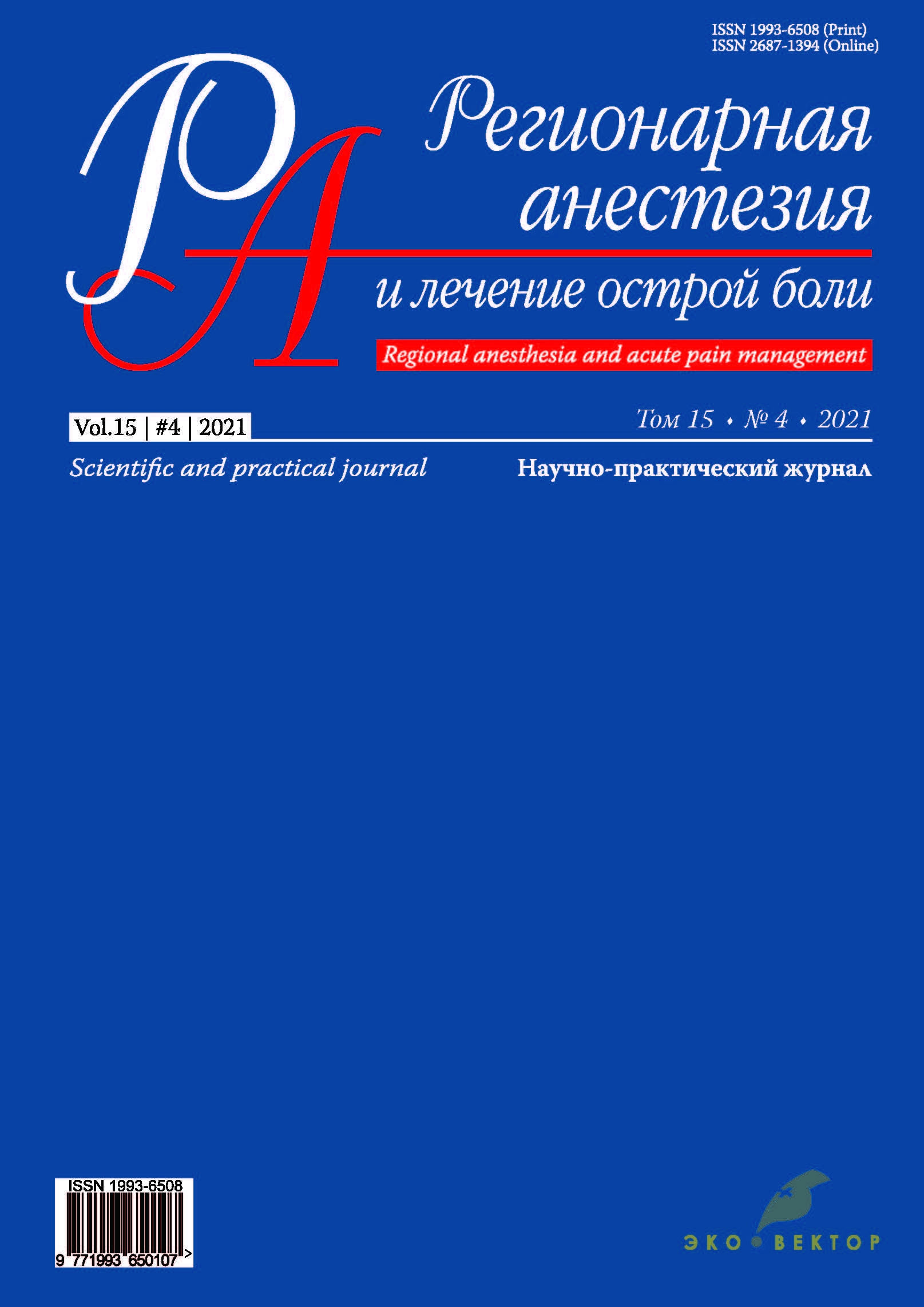Comparative analysis of monolateral and bilateral spinal anesthesia
- Authors: Filimonov R.V.1, Gritsenko S.N.1, Filimonova I.V.1, Kobelyatskyy Y.Y.2
-
Affiliations:
- Zaporozhye Medical Academy of Postgraduate Education
- Dnepropetrovsk Medical Academy
- Issue: Vol 15, No 4 (2021)
- Pages: 237-244
- Section: Original study articles
- Submitted: 18.06.2022
- Accepted: 18.06.2022
- Published: 15.09.2021
- URL: https://rjraap.com/1993-6508/article/view/108819
- DOI: https://doi.org/10.17816/RA108819
- ID: 108819
Cite item
Abstract
AIM: This study aimed to improve the treatment results of patients with diabetic foot syndrome by substantiating the optimal type of spinal anesthesia during foot surgery.
MATERIALS AND METHODS: Sixty-four patients undergoing purulent surgery were examined and group as follows: Group 1 – patients operated on under monolateral (unilateral) spinal anesthesia and Group 2 – patients operated on under conditions of bilateral (traditional) spinal anesthesia.
RESEARCH METHODS: Assessment of the level and intensity of pain and the level of catecholamines in urine was conducted in the first postoperative day. Cardiovascular system indicators and the temperature of the skin of the leg during anesthesia were monitored, and the Doppler scanning of peripheral circulation in the foot was performed.
RESULTS: Pain sensitivity during lower limb movement was 20% less pronounced in group 1 than in group 2. A 4.4% decrease in heart rate, a 4.7% decrease in saturation level recorded 20 minutes after the onset of anesthesia, and a 9.8% decrease in mean arterial pressure were observed in group 2. In both groups, systolic blood pressure in the toe increased by 18% after anesthesia, and the temperature of the skin on the lateral surface of the leg increased by 3%. Adrenaline concentration in the daily portion of urine in group 2 was 34.4% higher than that in group 1 in the next postoperative day.
CONCLUSIONS: The general condition of patients during anesthesia was more stable in group 1 than in group 2. After anesthesia, improved peripheral hemodynamics in the operated limb was noted. Compared with traditional spinal anesthesia, monolateral spinal anesthesia has a positive effect on the stress response of the patient’s body to surgical intervention.
Full Text
About the authors
Roman V. Filimonov
Zaporozhye Medical Academy of Postgraduate Education
Author for correspondence.
Email: roman.filimonow@gmail.com
ORCID iD: 0000-0003-3947-1339
MD, Cand. Sci. (Med.), assistant
Ukraine, ZaporozhyeSergey N. Gritsenko
Zaporozhye Medical Academy of Postgraduate Education
Email: gritsenko45@gmail.com
ORCID iD: 0000-0001-6391-8300
MD, Dr. Sci. (Med.), Professor
Ukraine, ZaporozhyeInna V. Filimonova
Zaporozhye Medical Academy of Postgraduate Education
Email: filimonovainna1975@gmail.com
ORCID iD: 0000-0003-2977-1223
MD, Cand. Sci. (Med.)
Ukraine, ZaporozhyeYuriy Yu. Kobelyatskyy
Dnepropetrovsk Medical Academy
Email: kobeliatsky@ukr.net
MD, Dr. Sci. (Med.), Professor
Ukraine, DniproReferences
- Byshovets SN. Anaesthetic component of the fast track surgery strategy:spinal anaesthesia with bupivacaine, prolonged by buprenorphine. Meditsina neotlozhnykh sostoyanii. 2017;1:93–98. doi: 10.22141/2224-0586.1.80.2017.94458
- Zayashnikov SV, Bautin AE, Iakovlev AS, et al. The Effectiveness of Neuraxial Anesthesia Techniques in Diabetic Foot Surgery. Regional Anesthesia and Acute Pain Management. 2017;11(2):90–97. (In Russ). doi: 10.18821/1993-6508-2017-11-2-90-97
- Boyko EJ, Monteiro-Soares M, Wheeler SGB. Peripheral Arterial Disease, Foot Ulcers, Lower Extremity Amputations, and Diabetes. In: Cowie CC, Casagrande SS, Menke A, Cissell MA, et al, editors. Diabetes in America. 3rd ed. Bethesda (MD): National Institute of Diabetes and Digestive and Kidney Diseases (US); 2018. CHAPTER 20. P:1–33.
- Vishwas A, Bhanushree D, Chethan B, et al. Diabetic foot ulcer: a review. World J Pharm Pharm Sci. 2017;(6):239–260.
- Wukich DK, Raspovic KM. Assessing Health-Related Quality of Life in Patients With Diabetic Foot Disease: Why Is It Important and How Can We Improve? The 2017 Roger E. Pecoraro Award Lecture. Diabetes Care. 2018;41(3):391–397. doi: 10.2337/dci17-0029
- Watt J, Tricco AC, Talbot-Hamon C, et al. Identifying Older Adults at Risk of Delirium Following Elective Surgery: A Systematic Review and Meta-Analysis. J Gen Intern Med. 2018;33(4):500–509. doi: 10.1007/s11606-017-4204-x
- Manokhina YA, Ulrikh GE. Regional Anesthesia for Children with the Diseases of Lower Limbs. Regional Anesthesia and Acute Pain Management. 2017;11(3):157–163. (In Russ). doi: 10.18821/1993-6508-2017-11-3-157-163
- Ovechkin AM, Politov ME, Panov NV, Sokologorsky SV. Anaesthetic care of patients undergoing primary hip and knee arthroplasty: evolution of views. Regional Anesthesia and Acute Pain Management. 2020;14(2):53–62. (In Russ). doi: 10.17816/1993-6508-2020-14-2-53-62
- Sobokar VA, Gritsenko SN, Potapenko MS. Comparison of influence of high thoracic epidural anesthesia and central analgesia on hemodynamic during on-bypass coronary artery bypass grafting. Zaporozhye Medical Journal. 2015;(3):60–64. (In Ukr). doi: 10.14739/2310-1210.2015.3.44487
- Garratt AM, Ruta DA, Abdalla MI, et al. The SF36 health survey questionnaire: an outcome measure suitable for routine use within the NHS? BMJ. 1993;306(6890):1440–1444. doi: 10.1136/bmj.306.6890.1440
- Young-Hyman D, de Groot M, Hill-Briggs F, et al. Psychosocial Care for People With Diabetes: A Position Statement of the American Diabetes Association. Diabetes Care. 2016;39(12):2126–2140. doi: 10.2337/dc16-2053
- Johnson RL, Kopp SL, Burkle CM, et al. Neuraxial vs general anaesthesia for total hip and total knee arthroplasty: a systematic review of comparative-effectiveness research. Br J Anaesth. 2016;116(2):163–176. doi: 10.1093/bja/aev455
- Kazanin AA, Zagrekov VI. Anesthetic management of patients with the syndrome of “diabetic foot” and critical limb ischemia. Medicina. 2018;6(1):42–71. (In Russ). doi: 10.29234/2308-9113-2018-6-1-42-71
- Kiasari A, Babaei A, Alipour A, et al. Comparison of Hemodynamic Changes in Unilateral Spinal Anesthesia Versus Epidural Anesthesia Below the T10 Sensory Level in Unilateral Surgeries: a Double-Blind Randomized Clinical Trial. Medical Archives. 2017;71(4):274. doi: 10.5455/medarh.2017.71.274–279
- Basenko ІL, Suslov OS, Volodichev DS. Rekomendatsії tret’ogo z’їzdu american society of regional anaesthesia stosovno sistemnoї toksichnostі mіstsevikh anestetikіv. Clinical Anesthesiology and Intensive Care. 2018;12(2):98–108. (In Ukr). doi: 10.31379/2411.2616.12.2.11
- Bishovets’ SM, Dzyuba DO. Odnobіchna subarakhnoїdal’na blokada dlya іntraoperatsіinogo znebolyuvannya plastiki pakhovogo kanalu. Meditsina nevіdkladnikh stanіv. 2020;16(2):49–52. (In Ukr).
Supplementary files







